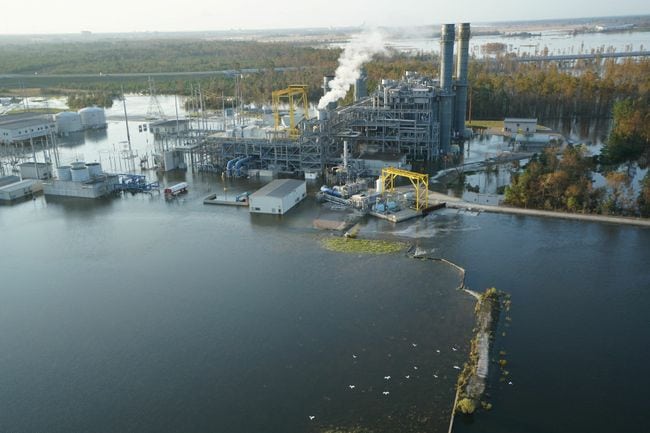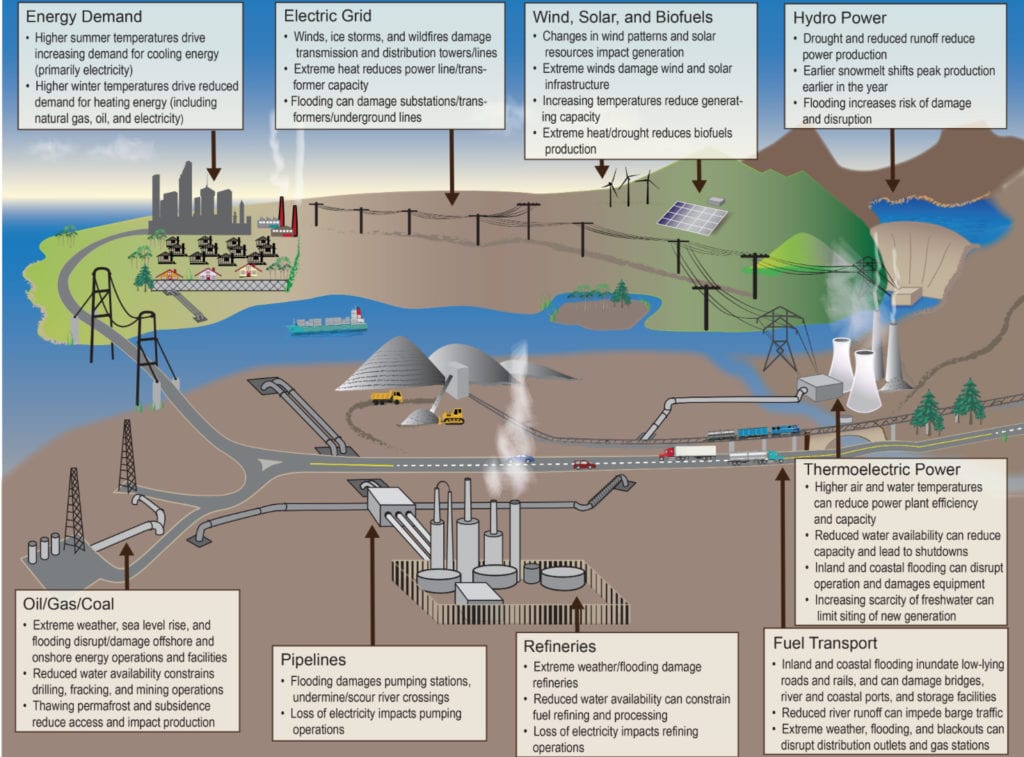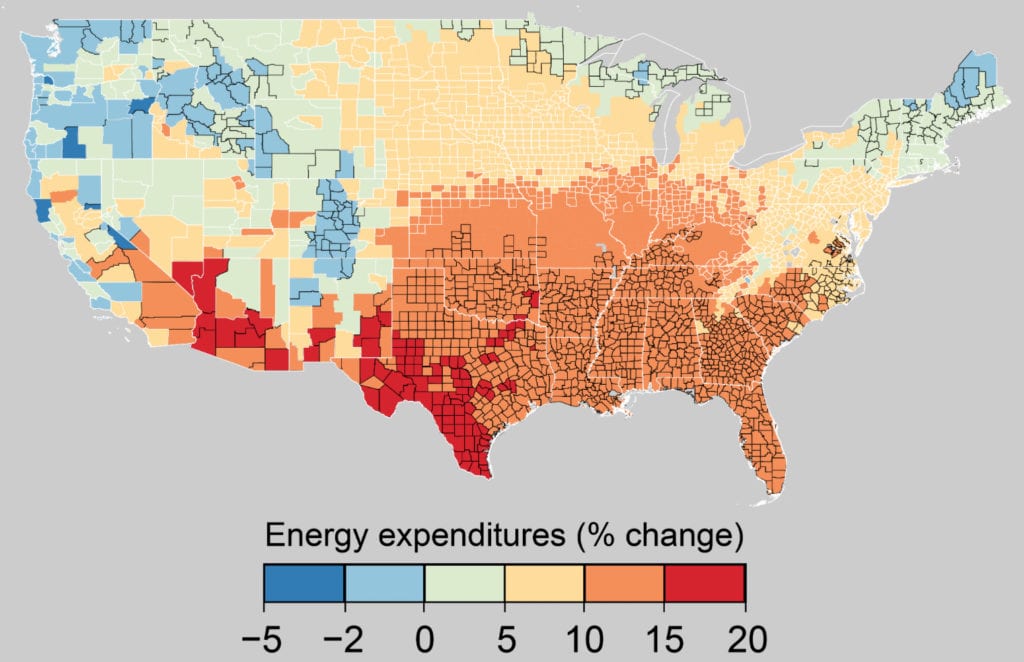Eight Power Sector Takeaways from the Climate Report
Despite increased resilience actions, extreme weather events due to climate change are projected to increasingly threaten the nation's energy infrastructure, and create fuel availability and demand imbalances, the Trump administration's sprawling climate report released on November 23 suggests.
The Fourth National Climate Assessment (NCA4) released by the Global Change Research Program (USGCRP) is clear in its premise: Human activity is adding carbon dioxide to the atmosphere at a rate far greater than it is being removed by natural processes, and the greenhouse gas (GHG) is driving the climate to a warmer and warmer state. "Today, the largest uncertainty in projecting future climate conditions is the level of greenhouse gas emissions going forward," it says.
While the assessment surveys several observed changes, and evaluates current and future risks aimed to inform decisions as they apply to the economy, infrastructure, the national environment, and human health and well-being, it contains achapter dedicated to climate change issues affecting energy supply, delivery, and demand. Here are specific conclusions that could affect the power sector.
- The energy sector faces transformative disruptions even beyond climate change considerations, and the effects of climate change create new, dangerous risks.
The assessment notes reliability, security, and resilience of the U.S. energy system, is already affected by extreme weather events "due to climate change," and it warns that reliable and affordable energy supplies are "increasingly at risk from climate change and weather extremes."
Along with electric service disruptions, caused by transmission and distribution outages, the report highlights vulnerabilities in fuel availability. While coal facilities typically store enough fuel onsite for at least 30 days of operation, "extreme cold can lead to frozen fuel stockpiles and disruptions in train deliveries."
Issues faced by the energy sector, specifically, will be compounded by its current transformation, which is driven by changes in policy, markets, and technology. "Natural gas and renewable resources are moving to the forefront as energy sources and energy efficiency efforts continue to expand, forcing changes to the design and operation of the Nation's gas infrastructure and electrical grid," it says.
However, though natural gas generation "generally improves electric system flexibility and reliability," gas supplies and midstream infrastructure is vulnerable to disruption. Natural gas capacity challenges on existing pipelines combined with difficulty in some areas of siting and construction of new gas pipelines, along with competing uses for natural gas (such as home heating), have created past supply constraints. Gas plants are also vulnerable to flooding. Solar and wind, too, can be impacted by extreme weather.

Floodwater entered the footprint of the 625-MW Sutton natural gas combined-cycle plant on September 21. Courtesy: Duke Energy
For now, "deliberate actions" are being taken to enhance energy security, reliability, and resilience as they relate to the effects of climate change-including integrating planning, energy technologies, and public-private partnerships. It adds: "Management of the myriad fuel storage challenges and their relation to climate change is a subject that would benefit from improved understanding."
The report concludes that system flexibility, reliability, and resilience are generally being enhanced by the "growing adoption" of energy efficiency programs, demand response programs, transmission capacity increases, and microgrids with energy storage technologies. Yet, "much work remains to establish a climate-ready energy system that addresses present and future risks," it says.
The issues the sector faces are wide and complex. For example, though the sector is increasing automation of energy systems-a factor that could help mitigate the impact of extreme weather-without appropriate preventative measures, it faces increased system vulnerabilities to cyberattacks and other systemic risks.
- The impacts of climate change have affected energy systems differently by region, but all regions will be affected by climate change.
Hurricanes of greater intensity and rising sea levels pose an increased risk of damage on electrical, natural gas, and petroleum infrastructure along the East and Gulf Coasts, and disruptions from these facilities will have national implications. Rising sea levels and extreme weather could also have implications for Hawaii. The Northeast and Midwest, meanwhile, face more frequent and intense "extreme precipitation events," which could increase the risk of floods for coastal and inland energy infrastructure.

Potential impacts from extreme weather and climate change. Source: Fourth National Climate Assessment (NCA4)
- Climate change unsheathes a double-edged sword for the power sector.
For the power sector, the changes pose both opportunity and threat. The sector is already seeing increased electrification of other sectors-such as telecommunications, transportation (including electric vehicles), banking and finance, healthcare, emergency response, and manufacturing. But temperatures are now also rising in all regions, it says.
By 2040, temperature increases alone are expected to drive a rise in annual electricity demand by 3% to 9% under the higher scenario, and 2% to 7% under the lower scenario. That could necessitate "the construction of up to 25% more power plant capacity by 2040, compared to a scenario without a warming climate." Meanwhile, despite efficiency gains, by 2040, residential and commercial electricity expenditures nationwide are projected to increase by 6% to 18% under a higher scenario, 4% to 15% under a lower scenario, and 4% to 12% under an even lower scenario.
For power generators, there's bad news: "Higher temperatures reduce the thermal efficiency and generating capacity of thermoelectric power plants and reduce the efficiency and current-carrying capacity of transmission and distribution lines," the assessment notes. That could be costly and reduce reliability.

Projected changes in energy expenditures.This figure shows county-level median projected increases in energy expenditures for average 2080-2099 impacts under the higher scenario. Impacts are changes relative to no additional change in climate. Source: NCA4, Hsiang et al. 2017
- The threat of extreme weather cannot be overstated.
Extreme weather-including high winds, thunderstorms, hurricanes, heat waves, intense cold periods, intense snow events, ice storms, and extreme rainfall-can interrupt energy generation, damage infrastructure, and interfere with fuel production and distribution systems. These events, which cause fuel and electricity shortages or price spikes, are "expected to continue growing in frequency and severity over the coming century." A widespread energy disruption can "take weeks to fully resolve, at sizable economic costs."
- Flooding and sea level rise will be disastrous for coastal power plants.
Nationally, a sea level rise of 3.3 feet (1 meter [m], which is "at the high end of the very likely range under a lower scenario for 2100") could expose "dozens of power plants that are currently out of reach of the risks of a 100-year-flood." That would jeopardize a cumulative total of 25 GW of operating or proposed power capacities. Sea level rise could increase the number of exposed facilities by 6% to 60%, depending on the scenario and intensity of a hurricane.
In the Southeast-along the Atlantic and Gulf Coasts-a Category 1 storm would potentially expose 69 power plants, while a Category 5 storm would expose 291. In Florida and Delaware, a sea level rise of 3.3 feet would double the number of vulnerable plants, putting 11 GW of capacity in Florida and 0.8 GW in Delaware at risk. In Texas, vulnerable capacity could more than triple-putting an additional 2.8 GW at risk.
Coastal substations would also be vastly exposed. For example, in southeastern Florida the number of major substations exposed to flooding from a Category 3 storm could more than double by 2050 and triple by 2070 under the higher scenario.
- Costs for repairs from recent storms have been astronomical.
Superstorm Sandy cost Con Edison and Public Service Electric and Gas more than $2 billion (in 2014 dollars). Building back Puerto Rico's electricity systems-after Hurricanes Irma and Maria decimated them-could cost about $17 billion (in 2017 dollars).
- Climate change threatens power plant water supplies.
Ambient temperature increases could elevate water temperatures, which would reduce power plant efficiency and could force plants to derate or shut down to comply with discharge temperature rules, as was evident at several nuclear plants around the world this summer. Elevated water temperatures could drastically affect output. Potential power plants cooled by river water could fall from 7.3% to 13.1% by 2050, under the low and high scenarios respectively, the assessment suggests.
Furthermore, reduced water availability will adversely affect hydropower, especially in western snow-dominated watersheds where declining mountain snowpack affects river levels. "For example, severe, extended drought caused California's hydropower output to decline 59% in 2015 compared to the average annual production over the two prior decades," it notes.
- Resiliency will be key.
Acting to improve resilience appears to be the soundest course of mitigation. Industry and governments at all levels have taken significant steps to improve resiliency-as well as to develop quantitative metrics to assess the economic and energy security benefits associated with these measures. "Energy companies, utilities, and system operators are increasingly employing advanced data, modeling, and analysis to support a range of assessment and planning activities," the assessment notes. While uncertainty continues to hinder infrastructure investment planning, advanced tools are now being developed to help inform decisions that balance costs as well as risk exposure. Meanwhile, long-term capital expansion strategies are increasingly considering system operations and resilience of supply chains, as well as the potential of mutual assistance efforts.
At the same time, accurate load forecasting and generation planning "now require considering both extreme weather and climate change," it notes. Planning of new coastal infrastructure, for instance, must take into account rising sea levels and flooding risks, while resource plans for new gas-fired power plants must consider disruptions to supply.
"For example, the inability of natural gas-fired power plants to store fuel on site is leading energy providers to explore various resilience options, such as co-firing with fuel oil, which can be more readily stored; improving information sharing and coordination between electric generators, gas suppliers, and pipeline operators; and, ensuring the availability of more flexible resources for use to mitigate the uncertainties associated with natural gas fuel risks," it says.
Finally, with every storm or extreme event suffered, lessons learned are proving valuable, and private and public-private partnerships are increasingly being used to share information and coordinate action. Power companies, for example, have embarked on hardening measures. These include "adding natural or physical barriers to elevate, encapsulate, waterproof, or protect equipment vulnerable to flooding; reinforcing assets vulnerable to wind damage; adding or improving cooling or ventilation equipment to improve system performance during drought or extreme heat conditions; adding redundancy to increase a system's resilience to disruptions; and deploying distributed generation equipment (such as solar, fuel cells, or small combined-heat-and-power generators), energy storage, and microgrids with islanding capabilities (the ability to isolate a local, self-sufficient power grid during outages) to protect critical services from widespread outages while promoting improved energy efficiency and associated appliance standards."
But improvements could still be made, it says. Among key barriers are a lack of reliable projections of climate change at a local level and associated risks to energy assets, as well as "a lack of a national, regional, or local cost-effective risk reduction strategy." It also urges exploring the resilience nexus between sectors, such as between water and energy, to identify co-benefits of resilience solutions and inform cost-effective resilience strategies.
The assessment also urges paying greater attention to the nation's aging energy equipment. It notes the majority of energy infrastructure dates to the 20th century; 70% of the grid's transmission lines and power transformers are more than 25 years old; and the average age of power plants is more than 30 years old. "The components of the energy system are of widely varying ages and conditions and were not engineered to serve under the extreme weather conditions projected for this century," it says.
About the Congressionally Required AssessmentThe assessment is congressionally required under the Global Change Research Act of 1990. Under the law, the USGCRP-a federal program that facilitates collaboration across 13 federal member agencies, including the Department of Energy (DOE) and the Environmental Protection Agency (EPA)-must deliver a report to Congress and the president at least every four years. The report must analyze current trends-both "human-induced" and natural-of "global change," as well as their effects on energy production and energy use, natural environment, land and water resources, transportation, human health and welfare, human social systems, and biological diversity.
The NCA4 splits the topics into two volumes. Volume 1 (The Climate Science Special Report), released last year, describes the foundational science behind how climate change is affecting the physical earth system across the U.S., whereas Volume 2 focuses on the national topics, paying attention to observed and projected risks, impacts, and possible risk reduction, as well as implications under different mitigation pathways. The National Oceanic and Atmospheric Administration (NOAA) led preparation of the report, but it was developed by a team of 300 volunteer federal and non-federal experts. Its development included a series of regional engagement workshops in more than 40 cities, along with listening sessions, webinars, and public comment periods.
-Sonal Patel is a POWER associate editor (@sonalcpatel, @POWERmagazine)
The post Eight Power Sector Takeaways from the Climate Report appeared first on POWER Magazine.